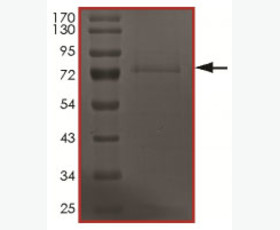Recombinant Human Casein kinase I γ-2/CSNK1G2
| Product name: | Recombinant Human Casein kinase I γ-2/CSNK1G2 |
| Source: | E. coli |
| Purity: | Greater than 95% as determined by reducing SDS-PAGE. |
| Buffer Formulation: | Supplied as a 0.2 μm filtered solution of 20mM Tris,500mM NaCl,10%Glycerol,1mM DTT, pH 8.0. |
| Applications: | Applications:SDS-PAGE; WB; ELISA; IP. |
| Storage: | Avoid repeated freeze/thaw cycles. Store at 2-8 oC for one month. Aliquot and store at -80 oC for 12 months. |
| UOM: | 100ug/50ug/200ug/1mg/1g |
| Source | E. coli |
| Description | Recombinant Human CSNK1G2 is produced by our E.coli expression system and the target gene encoding Met18-Lys415 is expressed with a 6His tag at the N-terminus. |
| Names | Casein kinase I isoform gamma-2, CK1G2, CSNK1G2 |
| Accession # | P78368 |
| Formulation | Supplied as a 0.2 μm filtered solution of 20mM Tris,500mM NaCl,10%Glycerol,1mM DTT, pH 8.0. |
| Shipping |
The product is shipped on dry ice/ice packs. |
| Storage |
Store at < -20°C, stable for 6 months after receipt. Please minimize freeze-thaw cycles. |
| Purity |
Greater than 95% as determined by reducing SDS-PAGE. |
| Endotoxin | Less than 0.1 ng/µg (1 IEU/µg) as determined by LAL test. |
| Amino Acid Sequence |
MGSSHHHHHHSSGLVPRGSHMSKAGGGRSSHGIRSSGTSSGVLMVGPNFRVGKKIGCGNFGELRL GKNLYTNEYVAIKLEPIKSRAPQLHLEYRFYKQLSATEGVPQVYYFGPCGKYNAMVLELLGPSLE DLFDLCDRTFTLKTVLMIAIQLITRMEYVHTKSLIYRDVKPENFLVGRPGTKRQHAIHIIDFGLA KEYIDPETKKHIPYREHKSLTGTARYMSINTHLGKEQSRRDDLEALGHMFMYFLRGSLPWQGLKA DTLKERYQKIGDTKRATPIEVLCENFPEEMATYLRYVRRLDFFEKPDYDYLRKLFTDLFDRSGFV FDYEYDWAGKPLPTPIGTVHTDLPSQPQLRDKTQPHSKNQALNSTNGELNADDPTAGHSNAPITA PAEVEVADETKCCCFFKRRKRKSLQRHK
|
| Background | CSNK1G2 is a cytoplasmic protein which contains one protein kinase domain. It is amember of the CK1 Ser/Thr protein kinase family of the large casein kinase I (CKI) subfamily. CSNK1G2 participates in Wnt signaling, involves in brain development and vesicular trafficking and neurotransmitter releasing from small synaptic vesicles. It regulates fast synaptic transmission mediated by glutamate. SMAD3 phosphorylation promotes its ligand-dependent ubiquitination and subsequent proteasome degradation, thus inhibiting SMAD3-mediated TGF-beta responses. |














